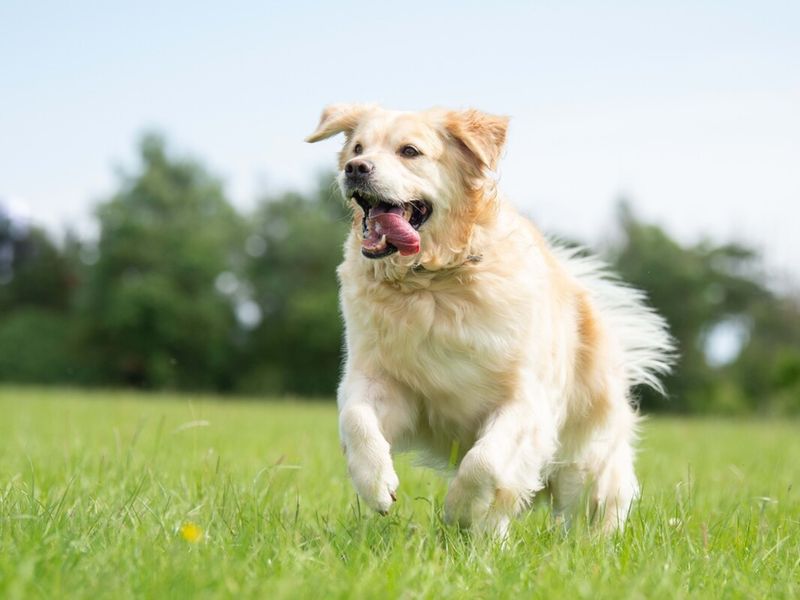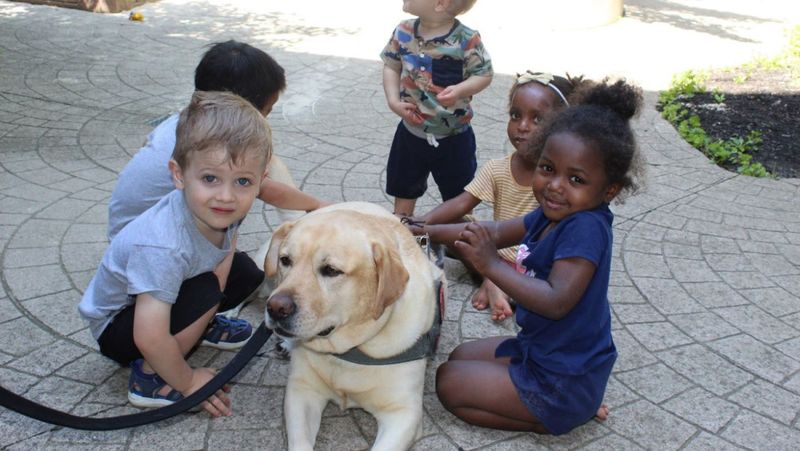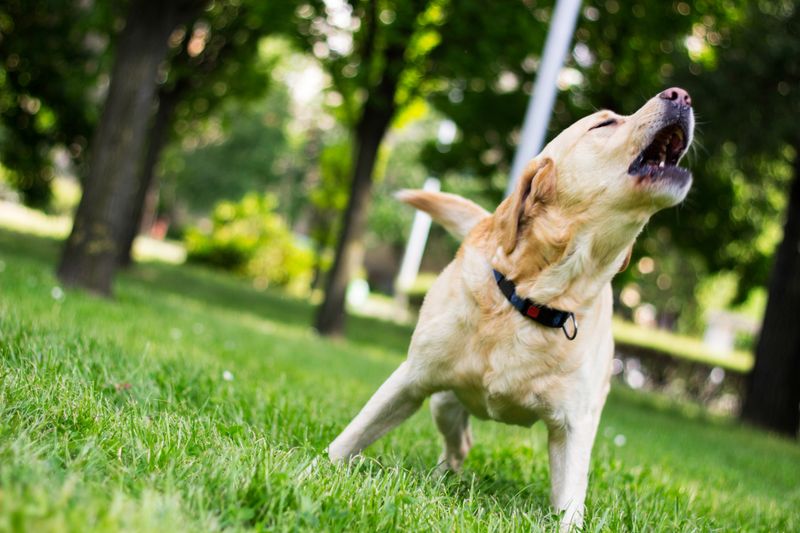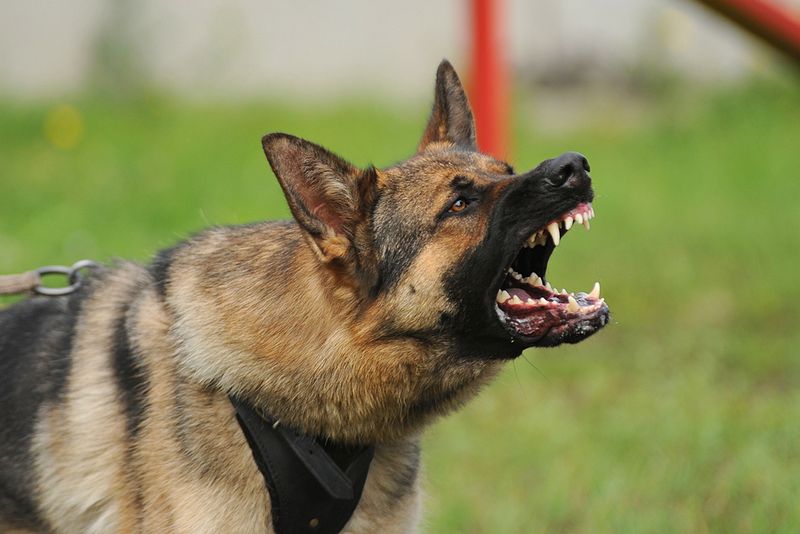Understanding your dog’s emotions is crucial to ensuring its well-being. Recognizing signs of happiness and distress can strengthen your bond and enhance your dog’s quality of life. Here are 8 signs that indicate your dog is happy, along with 8 signs that may suggest distress.
Wagging Tail
A wagging tail can be a clear indication that your dog is content. Dogs often wag their tails to express joy or excitement, especially when greeting their owners or during playtime.
However, the tail’s movement can vary in meaning. A slow wag might indicate curiosity or uncertainty, while a vigorous wag often signifies happiness.
Pay attention to the tail’s position. A tail held high with a moderate wag usually means your dog is happy. It’s a delightful sign, often accompanied by a playful demeanor or a bright, attentive gaze.
Playful Behavior
Playful behavior is a surefire sign of a happy dog. When a dog is in a playful mood, they might exhibit behaviors like bouncing, bowing, or playfully nipping at your hands.
These actions are often accompanied by a relaxed body posture and a wagging tail, showing their enjoyment. Dogs love to play fetch or tug-of-war, games that promote bonding and happiness.
A playful dog is usually a sign of a well-adjusted and emotionally healthy pet. This behavior not only indicates contentment but also ensures physical exercise.
Relaxed Body Language
When a dog is truly happy, its body language is relaxed and at ease. You might notice your dog sprawled out on its back, exposing its belly, which indicates trust and comfort.
A happy dog’s muscles will be relaxed, and they may have a soft, open mouth that almost looks like a smile.
This body language suggests that the dog feels secure in its environment. Watching for these signs can help you understand your dog’s emotional state and ensure its happiness.
Healthy Appetite
A healthy appetite is a good indication of a happy dog. When a dog is content, it will eagerly eat its meals and accept treats with enthusiasm.
A sudden decrease in appetite might signal distress or health issues, so a consistently healthy appetite is positive.
Feeding time becomes an enjoyable part of their routine, reflecting contentment and well-being. Pay attention to any changes in eating habits as they can provide insights into your dog’s emotional and physical health.
Good Sleep Patterns
If your dog enjoys regular, restful sleep, it is likely content and happy. Dogs need sleep to maintain their mood and overall health, with happy dogs often displaying regular sleep patterns.
They might nap during the day and sleep soundly through the night.
An irregular sleep pattern could indicate something is amiss, either emotionally or physically. Ensuring your dog has a comfortable sleeping area can enhance its happiness and well-being.
Social Engagement
Social engagement is key to a happy dog’s life. Dogs are naturally social animals and enjoy interacting with humans and other dogs.
If your dog actively seeks out social interaction and appears excited to meet new friends, it’s a positive sign. They might wag their tails, bark playfully, or show an eagerness to join in activities.
A happy dog will often be sociable, enjoying the company of others and participating in group play.
Bright Eyes
Bright, clear eyes are often a sign of a happy and healthy dog. When your dog feels content, its eyes will reflect that joy and vibrancy, often appearing alert and engaged.
A happy dog’s eyes will be free from discharge and have a lively sparkle.
This eye expression is often coupled with an overall enthusiastic demeanor. Watching your dog’s eyes can provide insights into their emotional well-being and happiness.
Barking with Joy
Barking can be a way for dogs to express their emotions. When a dog barks with joy, it often sounds different from a bark of distress or fear.
Joyful barking is usually high-pitched and accompanied by a wagging tail or playful jumps.
It can occur during playtime or when they see their favorite person. Recognizing the tone and context of the bark can help you distinguish between happiness and other emotions.
Whimpering or Crying
Whimpering or crying can indicate distress in dogs. These vocalizations might occur when a dog is anxious, scared, or in pain.
Pay attention to the context; if your dog whimpers when left alone or in new environments, it might be experiencing separation anxiety or discomfort.
Understanding and addressing the underlying cause is crucial for alleviating your dog’s distress and ensuring its well-being.
Aggressive Behavior
Aggressive behavior can be a sign of distress or fear in dogs. This might include growling, snapping, or biting, often resulting from feeling threatened or anxious.
Understanding the triggers is essential for managing aggression. It might stem from past trauma, a lack of socialization, or environmental stressors.
Recognizing and addressing these triggers can help in reducing aggressive behavior and improving your dog’s emotional health.
Avoidance or Hiding
When a dog is distressed, it might seek solitude by hiding or avoiding interaction. This behavior can indicate fear or anxiety, especially if the dog isolates itself from people or other animals.
Observe your dog’s behavior to identify stressors or environmental changes that might be causing this reaction.
Addressing the root cause and providing comfort can help reassure your dog and reduce its distress.
Excessive Panting
Excessive panting can be a sign of distress or discomfort in dogs, especially when not related to physical exertion or heat.
It might indicate anxiety, pain, or even an underlying health issue.
Monitoring your dog’s panting patterns and consulting a vet if you notice abnormal breathing can address potential problems early and ensure your dog’s well-being.
Lethargy and Fatigue
Lethargy or fatigue in dogs can indicate distress or health issues. If your once-energetic pet suddenly becomes listless, it might be experiencing emotional or physical discomfort.
Factors could include illness, stress, or depression.
Regular exercise and mental stimulation are important, but if lethargy persists, consulting a veterinarian can help determine the cause and appropriate treatment.
Pacing and Restlessness
Pacing and restlessness can be signs of anxiety or distress in dogs. This behavior often indicates that they are uncomfortable or unable to settle, possibly due to stress or external factors.
Pay attention to when and where this behavior occurs to identify potential triggers.
Addressing these factors can help calm your dog and improve its emotional state.
Loss of Appetite
A loss of appetite can be a sign of distress or health issues in dogs. If your dog suddenly becomes disinterested in food, it might indicate anxiety, depression, or illness.
Ensure that there are no changes in diet or environment causing this reaction.
Consulting with a veterinarian can help identify the underlying cause and address it effectively.
Destructive Behavior
When dogs engage in destructive behavior, it can indicate distress or boredom. Chewing furniture, digging holes, or shredding toys might be a dog’s way of coping with anxiety or lack of stimulation.
Identifying the cause of this behavior is crucial to address it properly.
Providing adequate mental and physical stimulation can reduce destructive tendencies and improve your dog’s well-being.
















